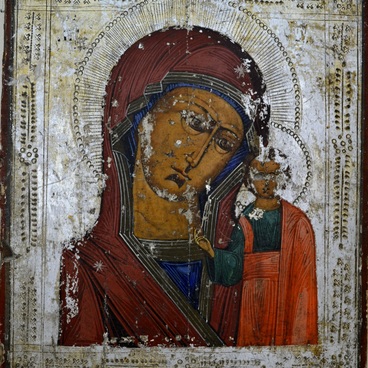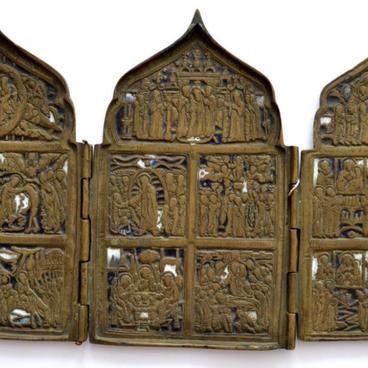The icon St. George and the Dragon was cast of a copper alloy by an unknown author in the 19th century. It shows St. George the Victorious, a warrior from Cappadocia, loved by the Orthodox people for his courage and heroic deeds. The major deed was believed to be the victory over the Dragon sent by God to the ancient city of Laosia as punishment for worshipping pagan gods.
St. George and the Dragon
Creation period
19th century
Dimensions
9x8 cm
9 х 8 х 0.5 cm
9 х 8 х 0.5 cm
Technique
Copper alloy, casting
Collection
Exhibition
1
Open in app#1
Unknown Author
St. George and the Dragon
#6
#3
Selevinus, the King of Laosia, failed to kill the Dragon, therefore he suggested to feed a child from each family, including the King’s one, to the Dragon. As the legend goes, when it was the turn for the King’s daughter Elisava to be fed to the Dragon, St. George the Victorious arrived in the city. He saved the king’s daughter from death and told her to bring the Dragon, tied up with her waist-belt, to the city. The warrior appealed for the citizens to adopt Christianity and speared the Dragon in full view of everyone.
Thankful citizens and the King of Laosia took baptism on the same day, and, in the city, there appeared a magic water spring that healed all the ailments. Princess Elisava devoted herself to service of Jesus Christ. This legend formed the basis of St. George iconography. The first icons dedicated to this subject appeared as early as in the 12th century.
#2
St. George and the Dragon (the front side and the back side)
#4
The icon “St. George and the Dragon” presents an extended version of the famous subject. Alongside with the warrior, the princess is shown to lead the dragon, tied up with her waist-belt, to the city. St. George thrusts his sharp spear into the winged Dragon.
All the images in the icon are symbolical. The princess signifies the Church, while the Dragon signifies idolization. By killing the Dragon, St. George the Victorious establishes Christianity and saves the earth from pagan heresy.
All the images in the icon are symbolical. The princess signifies the Church, while the Dragon signifies idolization. By killing the Dragon, St. George the Victorious establishes Christianity and saves the earth from pagan heresy.
In this version the painter has shown also the God of Sabaoth in the sky above the Victorious. Sabaoth symbolizes the heavenly host: the moon, the sun, stars and angels who assist Jesus Christ in his fight with the powers of evil. His appearance in the icon means that God blesses the Holy Hierarch and supports him in his battle with the Dragon.
The picture in the icon is embossed and clear-cut; there is a fortress in the background. The image is margined with a frame with a floral ornament. The back side of the icon is smooth, however with chipped spots and marks of grinding with a filer.
The picture in the icon is embossed and clear-cut; there is a fortress in the background. The image is margined with a frame with a floral ornament. The back side of the icon is smooth, however with chipped spots and marks of grinding with a filer.
#7
Iskitim Municipal Museum of Arts and History
read morehide
00:00
00:00
1x
St. George and the Dragon
Creation period
19th century
Dimensions
9x8 cm
9 х 8 х 0.5 cm
9 х 8 х 0.5 cm
Technique
Copper alloy, casting
Collection
Exhibition
1
Open in app
Share

